 |
||
|
||
| ||
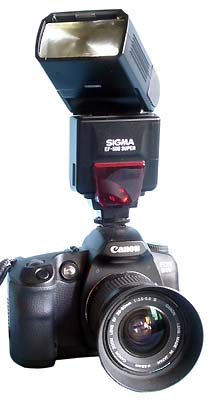 
A digital photo has passed the time when an internal flash was satisfactory. Today powerful additional flashes are on the top. But they must be synchronized with the camera. I decided to start description with flashes from Sigma, which is known as a manufacturer of lens and attachments to cameras from other companies (apart the production of its own photo cameras). The flashes under consideration have almost the maximum set of possible functions and a moderate price ($165 and $185 respectively). They are produced in 4 versions: for cameras of Sigma, Canon, Minolta and Nikon. The differences are connected both with pins in a hot shoe for quick attaching of a camera, and with operation of auto system of definite cameras. We have tested the flashes designed for the cameras from Canon. The 430 SUPER was tested entirely with the EOS D30 and EOS 50, since the box contains the manual for the 430 ST, and the site offers only superficial description of the camera's possibilities. But the testing of the 430 was interrupted at the most interesting moment because of problems in high-voltage circuit (according to the service center). The Flash Servicing Center made a conclusion about impossibility of the repair. Since the product was quite rare, there was nothing to replace it with, and I had to wait for the latest 500th model to continue the tests. Main flash modes.TTL. These flashes work with the Canon cameras in the ETTL mode. The ETTL is a new way of exposure metering when working with a flash. The exposure metering is implemented according to the light reflected from an object and passed through the lens. But while in the TTL mode the metering is implemented during shooting according to the light, reflected from the film, and an impulse broken after the camera receives enough light, the ETTL mode deals with a preliminary flash to define exposure parameters and necessary power of the flash. This mode appeared in the Canon EOS Elan II cameras together with Speedlight 380 EX and 220 EX flashes in 1995. A preliminary flash is used to estimate a signal until a mirror of the camera is lifted up. The A-TTL mode also uses a preliminary flash. But in this mode power of the flash is controlled according to the light reflected from the film, and a pre-flash is used to define a distance from an object and to calculate a necessary aperture. X synchronization with the first or second shutter. A flash can be synchronized with the camera when a focal curtain shutter is open completely according to the first or the second shutter, i.e. in the first case the synchronization is being implemented when the first shutter reaches an end of a frame, in the second case - when the second shutter starts moving. You can set this mode for a built-in flash by choosing a respective item in the menu of the camera, but when an external flash is attached, the settings of the camera are ignored and a synchronization type must be set from the flash's menu. The Canon EOS D30 allows using this mode only with the exposure equal to 1/30 or more. With the shorter exposure the synchronization will be implemented always according to the first shutter. 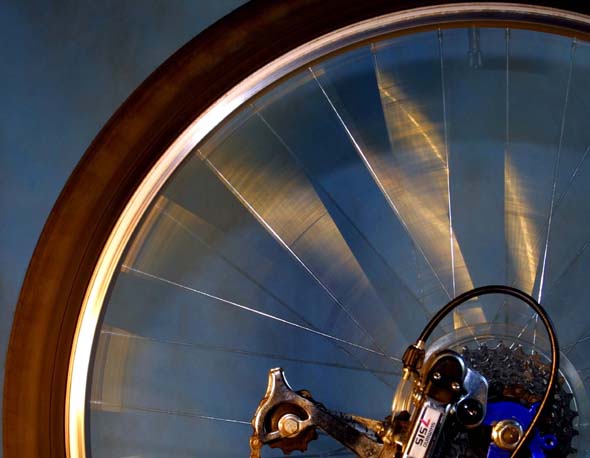 1/30s. Synchronization according to the first shutter. The wheel rotates clockwise. 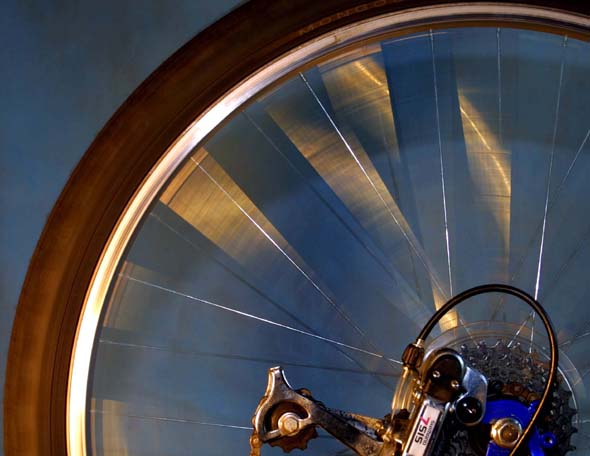 1/30s. Synchronization according to the 2nd shutter. FP. Operation of the flash at short exposure without a complete opening of the shutter is also possible. In this case each part of the frame is exposed for a short time, e.g. 1/2000 s, while the opposite edges of the frame are exposed at the interval equal to the time of a complete opening of a shutter, i.e. for the cameras like Canon EOS 50 it is 1/125, and for the D30 it is 1/200. I.e. if you need a "frozen" shot of a fast moving object, then you must shoot at long exposures since an impulse of the flash is very short, and if powers of the flash and surrounding light differ much, the exposure will depend exactly on the duration of the flash. Synchronization of the flash with short exposures is used far not for shooting of fast passing events. This mode should be used when an illumination level if high, and the flash is necessary only to lighten shadows. By reducing the exposure, you also cut a contribution of the permanent light into the exposure of the frame. The flash thus switches a stroboscopic mode with a very high frequency (around 50 kHz), and when passing a slit of the shutter each part of the frame is illuminated with the flash. As a result, the total duration of an impulse will equal a time of travel of the shutter along the frame (e.g., 1/200 s for the EOS D30), while each unit impulse lasts less than 1/ 50000 s. 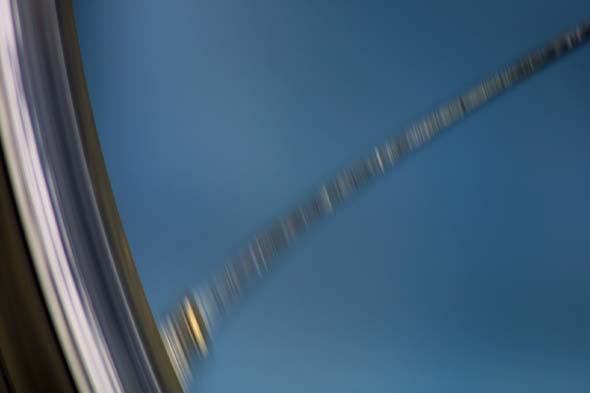 FP synchronization. 1/4000 s. It is well noticeable that different parts of the spoke were shot not at the same time, that is why it looks like being curved. 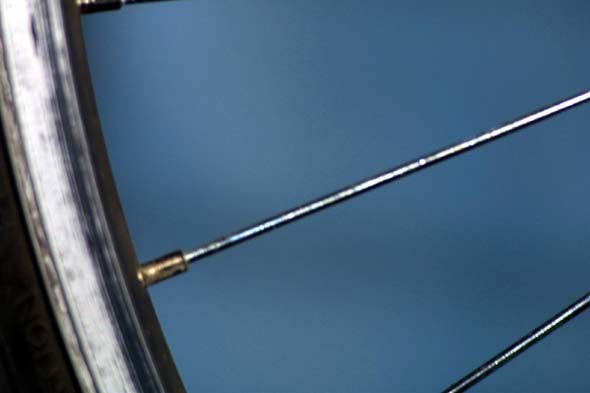 X synchronization with the shutter being open entirely. 1/60 s. This mode has become widespread not so long ago, and many companies look at it as at some technical breakthrough. But the history of synchronization on short exposures goes back to 50s. The Zeiss Ikon Contax II A camera, released in 1954, had an M-synchronization for a shutter speed equal to 1/30; X - for 1/50 and FP for 1/100 and shorter. The flashes adjust a beam of light with a visual angle of the lens with respect to its focal length within the range of 28-105 mm. The flash shifts a source of light automatically relatively to the Frensel lens in order to change an angle of the beam of light. We can also set a split of the beam of light manually. For operation with superwide-angle lenses the 430 flash is supplied with an additional diffuser. The 500th model has it built in in the case, and when you moves it out, a focal length equal to 17 mm is induced. Shift of the lamp's head in a vertical plane is implemented in both flashes. In the 500th model it is possible in a horizontal plane as well. This way an object is illuminated with the light reflected from a ceiling or a wall. Flash power can be varied in the range up to 1/16 of the full power of the 430 model and up to 1/128 of the 500. A stroboscopic mode allows tracking phases of motion of an object, the 430 model makes a series of flashes at intervals of 0.1; 0.2; 0.5 and 1 s. This flash has a separate stroboscopic mode for sports shooting. In this mode we have 18 flashes at the interval of 0.02 s. This model allows setting the frequency in the range from 1 to 199 Hz in 1 Hz steps. 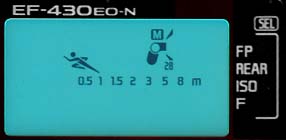 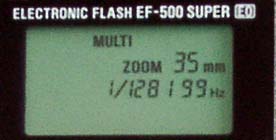  Remote control. The flashes can be synchronized with the camera without being connected with it with cables. In this case the synchronization is implemented according to a light pulse from the flash attached to the camera. If exactly the same flash is attached to the camera, then the synchronization is implemented not only in time but also in the power of the impulse. Data are exchanged between the flashes via an IR channel (you can set 4 independent channels). The system allows using up to three slave flashes in an automatic synchronized mode and setting a ratio of energies of their impulses. The absolute values of energies will be defined by the auto system according to the exposure metering after a preliminary flash. 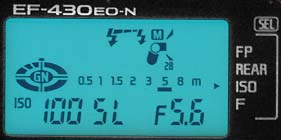 If a built-in flash is used as master, we can watch just a synchronous flash, the power of which can be set manually up to 1/16(430) or 1/128 (500). The camera is equipped with a calculator which shows at what distance and at what aperture an object will be illuminated the required way. If a built-in flash works in the ETTL mode, be careful since the Sigma flash may work from a preliminary impulse. That is why I recommend you to use the AE-lock mode (a button marked with an asterisk on the EOS cameras) to have a pre-flash and to fix exposure parameters; when pressing a release button a preliminary impulse won't take place any more. One can also use the flash with cameras which have only a standard 2-pin connector; in this case you should set the mode of a distantly controlled slave flash, like in the case of synchronization according to a light pulse. Apart from the possibilities mentioned above, the flash can be used for backlighting of an auto-focus in case of lack of light. But there are some problems: the EOS D30 uses only its own backlight for auto focus in all cases. It may be connected with the color of the backlight: the Sigma and EOS 50 have it red, the D30 has it white. Besides, there is backlight for an LC-display to control the flash in the complete dark. ConclusionThese are super-automatic flashes at the attractive price. They can be used in an automatic, camera-synchronized mode, with the flash attached to the camera being capable of controlling distantly of 3 more synchronized flashes. If necessary you can use the flashes in a non-auto mode with the synchronization according to the light pulse from a built-in flash of any camera, or connect to a standard synchronizer of camera which do not support an auto mode. But you must forget a stroboscopic mode in this case. The flashes differ in power of an impulse. The leading number for the 430 is 43, for the 500 is 50. The leading number makes possible to calculate aperture which is necessary to be installed for the right exposure when shooting on a film of 100 ISO. You must divide the leading number by the distance to an object. The second difference consists in a stroboscopic mode. The 500 model allows setting the frequency from 1 to 199 Hz in 1 Hz steps, and the 430 - 1, 2, 5, 10 and 50 Hz. The third difference consists in a possibility
of rotation in a horizontal plane which is realized only in the
500 model.
Write a comment below. No registration needed!
|
Platform · Video · Multimedia · Mobile · Other || About us & Privacy policy · Twitter · Facebook Copyright © Byrds Research & Publishing, Ltd., 1997–2011. All rights reserved. |